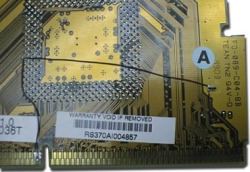| Hot Rod for 2000: Dual Celeron
by Leonard "Viking1" Hjalmarson |
||||
|
Back when I was in my teens cars were the measure of all things good in the world. My friends and I spent our spare time and extra cash making our street machines into hot rods. I remember a particular 1969 metallic blue Camaro I used to drool over. When Ted installed his high rise manifold and dual carburetors, it was the hottest machine on the block. My friends and I have grown older and wiser(?), and we're tired of bruised knuckles and speeding tickets. But we haven't entirely left speeding behind! These days a safer and cleaner hobby is the rage among gamers, and with the accelerating evolution of computer hardware, it keeps getting cheaper and easier to build the dream machine. WIN2000 and SMP Everyone knows that two turbos is better than one. In the same way, two processors will beat out one, right? Well, not necessarily. In fact, under WIN98 two processors might as well be a V6 engine with six more cylinders sitting in the back seat. WIN98 will not recognize the second processor, and neither will nine out of ten games that you might run. Falcon 4.0, MiG Alley and other coming games WILL take advantage of that extra processor, but not under WIN98.
 MiG Alley If you happen to be running NT it's a different matter. And in case you haven't yet heard, NT will soon be no more, and WIN99 ain't gonna happen. Instead, Microsoft is taking the best of these operating systems and combining them in a new super system called WINDOWS 2000, slated for release this fall. WIN2000 DOES recognize more than one processor, and if your software is written to support symmetrical processing, a dual processor system will be HOT. Yeah, sure, but who can afford it?
|
 The Dual Celeron Evolution Not long ago the first symmetrical processing Celeron machines appeared on the Internet, and the bravest of the brave trotted out their hobby drills and soldering irons to make a crack at it. After all, with a bit of fine wire, a steady hand and some luck one could have the dual processor dream machine for a song and a prayer. But drilling and wiring? Still too esoteric for most of us. The concept was sound, however. The Celeron is based on the same Deschutes core as the existing Pentium II CPUs, which can be run in multiprocessor mode easily enough. But Intel, in their infinite wisdom, disabled SMP on the external circuitry. Note: they did NOT remove the ability from the processor core itself. The Celeron represents an interesting evolutionary story in itself, since it was designed to compete with AMD's K6 in price and performance. In order to achieve this and not hamper PII sales, Intel removed the cache. But the cacheless Celeron, while clearly in a different performance ballpark than the PII and cheaper as a result, was a weak performer. When consumers complained, INTEL repented and put L2 cache back into the Celeron. With its 128K of L2 cache, only one quarter of that found in its paternal twin, the Celeron amazed all and sundry by performing on par with the Pentium II. The smaller cache, running at full clock speed compared to the slower external cache of the PII, made all the difference. As benchmarks poured in gamers took note, and the ease of overclocking made the Celeron the price-performance champ. (See our earlier article on Overclocking.) Given this scenario, it was only a matter of time before some enterprising individuals managed to re-enable multiprocessing on the Celeron. The release of adapters for the PPGA Celeron so that it could be used in a Slot 1 motherboard made the task simpler, requiring only a single wire to be added to an adapter board rather than on the CPU itself to allow symmetrical multiprocessing (SMP for short.) The industry was watching, and so arrived the next chapter in this story. Go to Part II
|
|||
|
Copyright © 1997 - 2000 COMBATSIM.COM, INC. All Rights Reserved. Last Updated May 5th, 1999 |
||||
